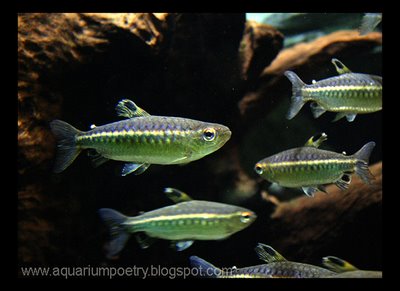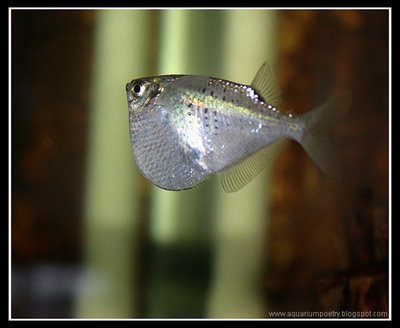 Phenachogrammus interruptus.
Phenachogrammus interruptus.The Congo Tetra are found in the upper Congo Basin, Africa. The Congo Tetra has opalescent scales that shine in all the colors of the rainbow, and it's tail fin develops into a most beautiful feathery appendage. The Congo Tetra is the most gorgeous of the true African tetras.
The body of this fish an elongated typical tetra shape with rather large scales. When mature, the fluorescent colors of the Congo Tetra run through the fish from front to back starting with blue on top changing to red through the middle, to yellow-gold, and back to blue just above the belly. The fins are grayish violet with white edges. An incredibly beautiful fish.
The Congo Tetra is a
peaceful schooling fish and needs a large aquarium, not only to provide plenty of room to swim around, but to thrive and develop their full beauty as well.
The Congo Tetra prefers soft, peat filtered water and a darker substrate. They are most comfortable in an aquarium with lower light levels which can be provided by floating plants. The beautiful rainbow colors of this fish will also show off best in lower light levels.
Since they are omnivorous the Congo Tetra will generally eat all kinds of live, fresh, and flake foods. To keep a good balance give them a high quality flake food everyday. Feed brine shrimp (either live or frozen) or blood worms as a treat.
The males get up to 8 cm and females up to 6 cm. The male is larger with more color, also the tail fin and dorsal fin are more extended.
They are generally a good community fish but they may try to bite smaller fish. Also, watch that they don't eat your smaller plants. They sometimes like to nibble on softer plants and young shoots.
Photo by Dusko Bojic.
 Trichopsis pumila
Trichopsis pumila Trichopsis pumila
Trichopsis pumila Originates from West Africa, ranging from Lagos in Nigeria to the Niger delta. Arnoldichthys spilopterus grows to 10 cm and is a peaceful shoaling fish. Eats live and prepared food.
Originates from West Africa, ranging from Lagos in Nigeria to the Niger delta. Arnoldichthys spilopterus grows to 10 cm and is a peaceful shoaling fish. Eats live and prepared food. Violet Betta
Violet Betta

 Trichogaster leeri
Trichogaster leeri Helostoma temminckii.
Helostoma temminckii. Colisa lalia.
Colisa lalia.
 Poecilia reticulata
Poecilia reticulata
 Phenachogrammus interruptus.
Phenachogrammus interruptus.

 Hemigrammus bleheri
Hemigrammus bleheri


 Paracheirodon axelrodi
Paracheirodon axelrodi